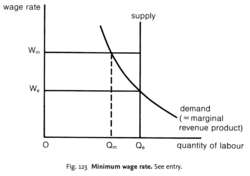minimum wage rate
the minimum rate of PAY for work either decreed by the government or voluntarily agreed between trade unions and employers. Minimum wage rates are designed to ensure that workers are able to enjoy some basic standard of living.In April 1999 the UK government introduced a statutory national minimum wage rate of £3.60p per hour for employees aged 22 and over and £3 per hour for employees aged 18-21; these rates have been increased progressively to £5.05p and £4.25p, respectively (as at October 2005). Many other countries have similar legislation. The minimum wage rate selected tends to reflect the outcome of a ‘compromise’ between various vested interests, the trade unions, employers and the government. Given the diversity of conditions in the LABOUR MARKET the introduction of a single economy-wide minimum wage is open to the objection that it will rarely correspond to ‘market-clearing’ rates in individual industries and trades. In particular, critics argue that pitching the wage rate too high (i.e. above the ‘market clearing’ rate) will tend, as noted above, to increase unemployment in many unskilled occupations. Moreover, there are practical complications relating to the imposition of the minimum wage rate where employees are traditionally paid on a ‘piece-rate’ basis rather than by the hour.
minimum wage rate
the minimum rate of PAY for LABOUR either decreed by the government or voluntarily agreed between trade unions and employers. Minimum WAGE RATES are designed to ensure that workers are able to enjoy some basic standard of living, thus correcting the MARKET FAILURE of low wages. However (as shown in Fig. 123), if wage rates are set much above the ‘equilibrium rate’, We, the effect is to reduce the demand for labour (from Qc to Qm ). Thus, although those who remain in work (OQm) are now better off, those persons who are made unemployed as wages rise (Qm Qc) are worse off.In April 1999 the UK introduced a statutory minimum wage rate of £3.60 per hour for employees aged 21 and over and £3 per hour for employees aged 18–20; currently (as at October 2005), these rates are £5.05 and £4.25 per hour, respectively. In October 2004 the minimum wage was extended to 16- and 17-year-olds at a rate of £3 an hour. Many other countries have similar legislation. The minimum wage rate selected tends to reflect the outcome of a ‘compromise’ between various vested interests, the trade unions, employers and the government. Given the diversity of conditions in the LABOUR MARKET, the introduction of a single economy-wide minimum wage is open to the objection that it will rarely correspond to ‘market-clearing’ rates in individual industries and trades. In particular, critics argue that pitching the wage rate too high (i.e. above the ‘market clearing’ rate) will tend, as noted above, to increase unemployment in many unskilled occupations. Moreover, there are practical complications relating to the imposition of the minimum wage rate where employees are traditionally paid on a ‘piece-rate’ basis rather than by the hour. See TRADE UNION, SUPPLY-SIDE ECONOMICS, MARGINAL-REVENUE PRODUCT, PROFIT-RELATED PAY.
